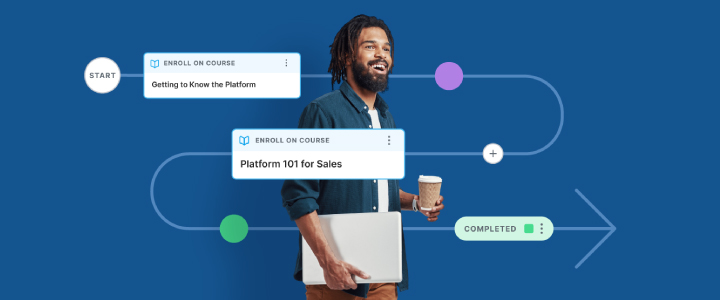
4 min reading time
Upskilling Your Workforce: How to Do it Through Training
Every organization wants to stay ahead of the curve. And, to achieve this you need two things – a great product or service and employees that are encouraged to upskill through training.
So, what exactly is upskilling? Well, it’s “the process of teaching your employees new skills as technology affords new opportunities and new jobs, which require specialized skill sets”.
Upskill training empowers your employees to not only improve their current abilities, but also to learn new skills that will expand the value they deliver to your growing organization. In this post, we’ll run through why you should make upskill training a top priority and how to implement it into your organization.
Benefits of upskill training
Up-to-date knowledge
Upskilling your employees keeps them knowledgeable on new processes, improves overall performance and, in turn, helps your business grow. Ultimately, it’s all about providing them with the skills they need to fulfill their current role, while also preparing them for their future careers.
Employee retention
If you want your employees to stick around for the long run, you need to invest in their learning and development. If an employee isn’t equipped with the new skills they need to progress and excel within your organization, they’re going to feel like they’re not prepared, or qualified, to successfully fulfill their role. Not only do challenges like this leave them feeling frustrated and disengaged, but it also impacts their productivity and, critically, your bottom line. All of these factors lead to low employee retention – the last thing you want.
Upskill training provides protection against high-turnover rates because it makes employees feel valued. It helps them see the path to career advancement right in front of them and gets them excited about what could be next. And, most importantly, happy employees equals improved productivity and better ROI for your organization.
Attracts new talent
Content employees who are enthusiastic about their place of work after upskilling, become brand ambassadors for your business – they’ll actively tell others about the investment being made in their career development. From spreading positive word of mouth to other industry professionals to writing glowing Glassdoor reviews, this attracts top talent to your organization, further helping it grow.
How to upskill staff
Now that you’re motivated by the benefits, it’s time to think about how you’re going to carry out upskilling. Here are some helpful tips on how to do just that.
Analyze your organization’s needs
First and foremost, you need to have a clear idea of what your business wants to achieve and also what your employees expect. If your organization already has a training strategy, analyze the ways you can improve it.
Talk to peers like co-workers, managers, and leadership to get their input. Sending around an organization-wide survey is an excellent way to quickly gather feedback on any skills gaps that exist. This information can then be brainstormed with stakeholders to come up with an upskilling plan of action.
Create a plan
This step is crucial – it gives you context and guidance on your goals for upskilling training. With all that invaluable feedback you gathered from your survey, start developing course ideas that could meet your employees’ needs. You might find there’s some upskill training already happening or a few quick-win topics that can be slotted into your current learning and development strategy.
Don’t omit what your organization needs either. Again, talk to managers and team leaders to find out the upskilling opportunities they believe they can help with and develop training for.
Culture for learning
An often-overlooked element of all corporate training, not just upskilling, it’s vital to build a culture of learning within your organization. This means encouraging your employees to understand the value of the learning on offer and giving them the opportunity and time to take their training. Upskilling shouldn’t just be seen as a benefit to your organization, but as the organization’s investment in your employees’ future careers.
Rewards also play a big part in encouraging this culture. Simple actions, like praising employees for taking time out of their busy workday to better themselves, are essential for creating, and nurturing, a positive learning culture.
How to deliver upskill training
Strategy in hand, it’s now time to decide how your business will provide upskill training to your workforce.
Face-to-face
Face-to-face training is exactly what it says on the tin – an instructor training a group or individual on a specific topic or skill in a classroom type setting. While this is a more traditional way of learning, it doesn’t always work for modern businesses. Once the training is scheduled, employees have to attend the course on the allocated day, time, and location – a major disadvantage if your employees have a pressing project deadline, other work commitments, life commitments, or work remotely.
Online learning
Online learning, or eLearning, is usually delivered through an LMS. This method of providing upskill training creates a centralized repository of courses that are easily accessible by employees with access to the LMS, no matter where they are in the world. LMS’s also come with features like automation, that cut down the time you have to spend doing admin work, improving productivity, and reducing admin costs. eLearning can be more engaging than traditional face-to-face training thanks to features like Gamification and Forums.
Blended learning
Blended learning is a “mix of traditional and non-traditional learning methods, like face-to-face and tech-based eLearning”. It offers a flexible way to train your employees. For example, if you’re running a live webinar training session that some employees are unable to attend, a recording of the session can be uploaded to your LMS for them to access at a later stage – anytime, anywhere, on any device. It’s also a great reference point for employees as they’ll be able to refer back to the recorded course at a later stage.
It’s a more cost-effective option too. Your organization only has to hold one instructor-led session instead of multiple sessions. Essentially, no employee will miss out on the opportunity to get the upskill training they need.
How does your organization deliver upskill training to employees? Let us know in the comments below.



